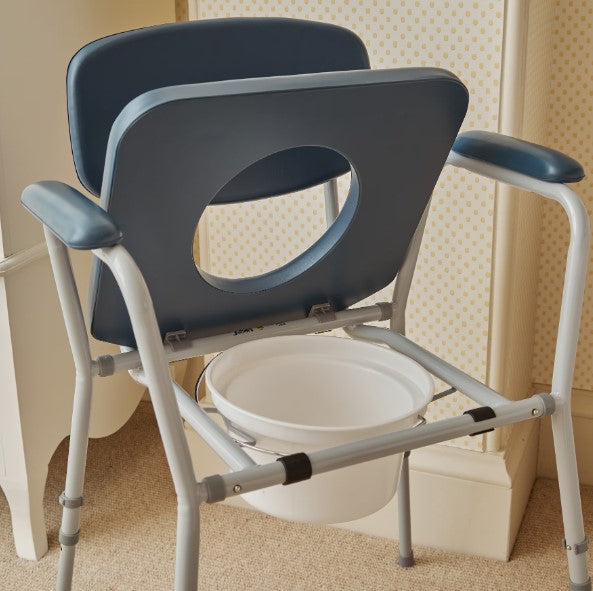Accessible sanitation is a fundamental necessity for individuals with mobility challenges. Whether it’s finding the right portable toilet or bedside commode, the right solution can transform daily life by restoring independence, dignity, and hygiene!
The Importance of Accessible Sanitation Facilities
For individuals with mobility challenges, accessible sanitation facilities are more than just a convenience—they’re essential for maintaining independence and dignity.
Tasks that many take for granted, like using the toilet, can become overwhelming without the right equipment.

Portable toilets and bedside commodes play a crucial role in meeting these needs. By providing accessible features like grab rails, adjustable heights, and compact designs, they reduce the physical strain on caregivers.
For example, a portable commode with a sealed waste system minimizes the need to clean the toilet every time it is used. By eliminating this requirement, caregivers can focus more on providing quality care and less on maintenance. This not only enhances convenience but also restores dignity for users who require assistance.
Good solutions enable users to participate fully in life, whether at home, outdoors, or in temporary setups, while reducing caregiver strain.
How to Choose the Right Disability-Friendly Portable Toilet
Selecting the ideal portable toilet involves assessing user needs, environmental factors, and equipment standards. Here’s what to consider:
1. Assessing Individual Needs
-
User-Friendly Design: Look for features like wide openings for easy access, non-slip surfaces to ensure stability, and simple operation such as a push button flush system. These features help users feel more confident and safe, especially those with limited mobility or strength.
-
Support Compatibility: Ensure the toilet can integrate with disability support rails or a hoist for added safety and independence.
-
Height Adjustability: Ensure the toilet is at a comfortable height to reduce strain during transfers.
2. Environmental Considerations
-
Versatility & Use: Check that the toilet is suitable for your required use i.e. at home, for trips, or in a vehicle.
-
Odour-Free Operation: Choose designs that control odour effectively. Smelling waste in your bedroom or vehicle is not pleasant and can be unsanitary for the long term.
-
Size for Individual Spaces: Compact designs are ideal for small or shared spaces, such as bedrooms or bathrooms. A discreet appearance ensures it blends seamlessly into the environment without drawing unnecessary attention.
-
Portability: Lightweight, compact designs ensure easy transport and setup wherever needed. If it is a semi-permanent fixture, ensuring the toilet is securely fixed to ground can be important to help avoid accidents.
-
Waterproof Design: If required check it can perform reliably in wet environments (i.e. in showers and/or bathrooms).

3. Long-Term Durability and Materials
-
Weight Capacity: Designed to support a wide range of users with stability and reliability. If for one person check the weight limit exceeds their individual weight by at least 10%.
-
Durability: Check reviews and the design to try ensure safety and long-lasting performance.
4. Caregiver Convenience
-
Odour-Free Disposal: Choose designs that control odour effectively and limit exposure to raw waste to improve the living and caregiving environment.
-
Hygienic and Chemical-Free: Look for chemical-free options that reduce maintenance tasks, chemical smells and exposure.
-
Simple Waste Disposal: Lightweight and easy-to-remove waste containers to simplify the process, avoid injuries and enable more people to assist in waste disposal process.
-
Low Maintenance: Options that minimize the need for regular cleaning or exposure to waste can greatly benefit caregivers.

Bedside and Shower Commodes: Features, Uses, and Scenarios
Bedside commodes are vital for individuals needing convenient and accessible toileting solutions. Here are the key types and their uses:
Standard Bedside Commodes
-
Features: Portable chairs with a built-in toilet seat and removable waste container.
-
Best For: Post-surgery recovery, elderly care, or individuals with temporary mobility limitations.
-
Maintenance Tip: Regularly empty and clean the container to prevent odours.

3-in-1 Commodes
-
Features: Functions as a bedside commode, raised toilet seat, and toilet safety frame.
-
Best For: Users needing extra stability or caregivers seeking multifunctional equipment.
-
Maintenance Tip: Inspect the frame for wear, especially after frequent adjustments.

Mobile Shower Commodes
-
Features: Water-resistant materials, wheels for mobility, and compatibility with showers.
-
Best For: Individuals with conditions that require toileting and showering support in the same location, such as those with severe arthritis, spinal injuries, or limited mobility post-surgery. These commodes reduce the need for transfers and provide a safe, efficient solution in wet environments.
-
Maintenance Tip: Rinse thoroughly after use to prevent rust or material degradation.

Portable Waterproof Dry Flush Toilets
-
Features: Completely self-contained units, no plumbing or wiring needed, lightweight and easy to set up. Designed to keep waste securely sealed and odour-free.
-
Best For: Suitable for users needing a portable and discreet solution in bedrooms, vehicles, or outdoor setups. Ideal for those who value hygiene and convenience, such as individuals recovering from surgery, elderly users, or those in remote areas.
-
Caregiver Benefits: Reduces caregiver workload by eliminating the need for frequent cleaning. The sealed bagging system prevents exposure to waste, offering a hygienic solution that’s simple to manage.
-
Durability: Heavy-duty materials ensure stability and longevity, with a high weight capacity and waterproof design for use in any environment.
-
Portability: Lightweight and compact, these toilets are easy to move and install wherever needed, making them an excellent option for temporary or emergency setups.
The Dry Flush Bedside Commode with lift kit and rails
See the video below on how it works and why it is considered a game changer and the best by some carers and users.
The Amazing Dry Flush Bedside Commode - see how it works
Maintenance and Hygiene: Keeping Your Equipment Safe and Clean
Proper maintenance ensures the longevity and cleanliness of your equipment. Here are key tips:
1. Cleaning Procedures
-
Wipe down surfaces daily with disinfectant or mild soapy water.
-
Deep clean removable parts weekly for optimal hygiene.
2. Odour Control
-
Use deodourising sprays or natural solutions like baking soda.
-
Dispose of waste and clean waste containers promptly to minimize odours.
3. Routine Inspections
-
Check for structural wear, especially in frames and handles.
-
Replace worn parts to ensure safety and reliability.
Frequently Asked Questions About Bedside Commodes
No Consent Needed: Hassle-Free Setup with Portable Toilets
Portable toilets designed for accessibility often require no building consent, plumbing, or electrical work, making them easy to install in any environment. This flexibility ensures:
-
Quick Setup Anywhere: Perfect for homes, temporary setups, or multi-level living spaces.
-
Portability: Can be moved between rooms, houses, or even vehicles without effort.
-
Non-Permanent Design: Ideal for renters or individuals needing a temporary solution.
This hassle-free setup is especially beneficial for individuals with disabilities, allowing them to maintain independence without delays or costly renovations.
Why Dry Flush Stands Out as a Premium Solution
While there are many accessible sanitation solutions, Dry Flush offers a revolutionary, user-friendly option that surpasses traditional portable toilets and bedside commodes. Here’s why it’s worth considering:
|
Feature |
How Dry Flush stacks up |
|
User-Friendly Design |
Same as a normal toilet with button flush and no odours. |
|
Setup and Install |
No plumbing, no wiring, no consent, easy to install. |
|
Support Compatibility |
Can easily add rails or use a hoist as needed. |
|
Height Adjustability |
Yes, with lift kit or other custom floor adjustments. |
|
Versatility |
Suitable for install in your home or vehicles. Can be easily removed or taken on trips if required. |
|
Portability |
Lightweight and compact 12.5kg (when empty) |
|
Weight Capacity |
Heavy-duty, supports a wide range of users up to 225kg |
|
Waterproof Design |
Yes, ideal for showers and humid environments (IXP4 water blast certified) |
|
Low Maintenance |
No cleaning or chemicals required as all waste is captured in the bagging system. |
|
Odour-Free Operation |
Yes, bagging system captures odours preventing any further smells after you flush. |
|
Simple Waste Disposal |
Waste doesn't have water so it is lightweight and easy-to-remove without coming into contact with waste. Make disposal also possible for most users, family members and carers without hygiene issues. |
The Dry Flush Specifications
1. Hygiene and Odour Control
Dry Flush toilets seal waste instantly in a self-contained bag, eliminating odours and reducing exposure to waste. This makes it a top choice for maintaining a hygienic and odourless environment.
2. Caregiver-Friendly Design
-
No Cleaning Required: The unique bagging system eliminates the need for scrubbing or chemical use, greatly reducing caregiver workload.
-
Simple Waste Disposal: Lightweight bags are quick and easy to remove, saving time and effort. Similar to adult diapers, sealed waste bags can be disposed of in the garbage.
3. Accessibility and Durability
-
Compatibility with Hoists & Rails: Dry Flush works seamlessly with mobility aids for users with limited mobility.
-
Adaptable Accessories: Includes options like a floor mounting plate for stability, a lift kit for extra height, and a cover to make your toilet more discreet if required.
-
Pee Powder and Urine: Some disability users have an easy system for urination without leaving their bed, so just rely on the Dry Flush for convenient solid waste management. Pee powder can also be used for liquid waste to minimise the use of bags.
4. Versatility and Portability
Whether at home, on trips, or in vehicles, Dry Flush provides a flexible and portable solution that adapts to various user scenarios.
5. Value for Investment
While Dry Flush may have a higher upfront cost, its benefits—hygiene, convenience, portability, and dignity—make it a reliable and best-in-class solution for users and caregivers alike.
Sanitation is one of the hardest elements to deal with when mobility is a challenge and worth making a hygienic, comfortable choice that will make the user and carers life more manageable.
The Dry Flush Bedside Commode
Click here to buy one now or talk to someone at Dry Flush
Conclusion: Finding the Right Accessible Sanitation Solution
Accessible sanitation is essential for improving the quality of life for individuals with mobility challenges.
By choosing the right equipment—whether it’s a portable toilet, bedside commode, or an innovative solution like Dry Flush—users and caregivers can enjoy enhanced independence, hygiene, and dignity.
For those seeking a hassle-free, odour-free, and accessible experience, Dry Flush stands out as a premium choice.
Interested or have any Questions?
Give us a call on 0800 124 227 or send an email to info@dryflush.co.nz.
The Dry Flush Demo
See us at FirstPort where you can look at getting extra financial support or advice.


